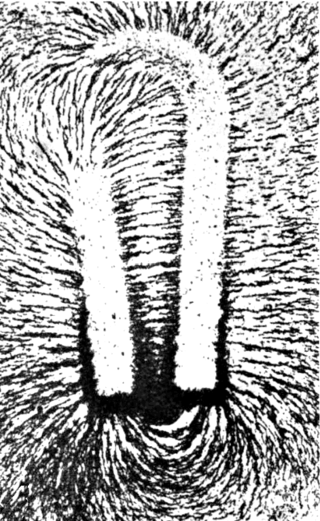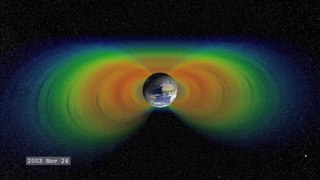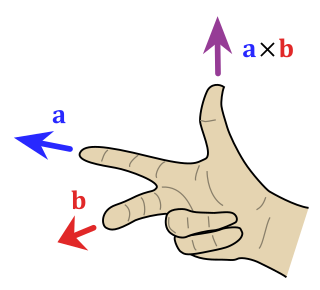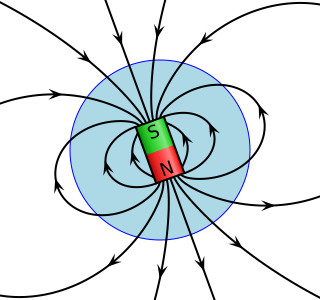
In physics, a dipole is an electromagnetic phenomenon which occurs in two ways:

In physics, electromagnetic radiation (EMR) consists of waves of the electromagnetic (EM) field, which propagate through space and carry momentum and electromagnetic radiant energy. Types of EMR include radio waves, microwaves, infrared, (visible) light, ultraviolet, X-rays, and gamma rays, all of which are part of the electromagnetic spectrum.

An electromagnetic field is a classical field produced by moving electric charges. It is the field described by classical electrodynamics and is the classical counterpart to the quantized electromagnetic field tensor in quantum electrodynamics. The electromagnetic field propagates at the speed of light and interacts with charges and currents. Its quantum counterpart is one of the four fundamental forces of nature.

Magnetism is the class of physical attributes that occur through a magnetic field, which allows objects to attract or repel each other. Because both electric currents and magnetic moments of elementary particles give rise to a magnetic field, magnetism is one of two aspects of electromagnetism.

In astronomy and planetary science, a magnetosphere is a region of space surrounding an astronomical object in which charged particles are affected by that object's magnetic field. It is created by a celestial body with an active interior dynamo.

A magnetic field is a vector field that describes the magnetic influence on moving electric charges, electric currents, and magnetic materials. A moving charge in a magnetic field experiences a force perpendicular to its own velocity and to the magnetic field. A permanent magnet's magnetic field pulls on ferromagnetic materials such as iron, and attracts or repels other magnets. In addition, a nonuniform magnetic field exerts minuscule forces on "nonmagnetic" materials by three other magnetic effects: paramagnetism, diamagnetism, and antiferromagnetism, although these forces are usually so small they can only be detected by laboratory equipment. Magnetic fields surround magnetized materials, electric currents, and electric fields varying in time. Since both strength and direction of a magnetic field may vary with location, it is described mathematically by a function assigning a vector to each point of space, called a vector field.

An electric field is the physical field that surrounds electrically charged particles and exerts force on all other charged particles in the field, either attracting or repelling them. It also refers to the physical field for a system of charged particles. Electric fields originate from electric charges and time-varying electric currents. Electric fields and magnetic fields are both manifestations of the electromagnetic field, one of the four fundamental interactions of nature.

A Van Allen radiation belt is a zone of energetic charged particles, most of which originate from the solar wind, that are captured by and held around a planet by that planet's magnetosphere. Earth has two such belts, and sometimes others may be temporarily created. The belts are named after James Van Allen, who is credited with their discovery.

Earth's magnetic field, also known as the geomagnetic field, is the magnetic field that extends from Earth's interior out into space, where it interacts with the solar wind, a stream of charged particles emanating from the Sun. The magnetic field is generated by electric currents due to the motion of convection currents of a mixture of molten iron and nickel in Earth's outer core: these convection currents are caused by heat escaping from the core, a natural process called a geodynamo.

In mathematics and physics, the right-hand rule is a common mnemonic for understanding the orientation of axes in three-dimensional space. It is also a convenient method for quickly finding the direction of the cross product of two vectors. Rather than a mathematical fact, it is a convention, closely related to the convention that rotation around an axis is positive if the sense of rotation as seen from the axis is counterclockwise and negative if it is clockwise.

In electromagnetism, the magnetic moment is the magnetic strength and orientation of a magnet or other object that produces a magnetic field, expressed as a vector. Examples of objects that have magnetic moments include loops of electric current, permanent magnets, elementary particles, composite particles, various molecules, and many astronomical objects.

Quadrupole magnets, abbreviated as Q-magnets, consist of groups of four magnets laid out so that in the planar multipole expansion of the field, the dipole terms cancel and where the lowest significant terms in the field equations are quadrupole. Quadrupole magnets are useful as they create a magnetic field whose magnitude grows rapidly with the radial distance from its longitudinal axis. This is used in particle beam focusing.

A dipole magnet is the simplest type of magnet. It has two poles, one north and one south. Its magnetic field lines form simple closed loops which emerge from the north pole, re-enter at the south pole, then pass through the body of the magnet. The simplest example of a dipole magnet is a bar magnet.

A levitated dipole is a type of nuclear fusion reactor design using a superconducting torus which is magnetically levitated inside the reactor chamber. The name refers to the magnetic dipole that forms within the reaction chamber, similar to Earth's or Jupiter's magnetospheres. It is believed that such an apparatus could contain plasma more efficiently than other fusion reactor designs. The concept of the levitated dipole as a fusion reactor was first theorized by Akira Hasegawa in 1987.

The ions and electrons of a plasma interacting with the Earth's magnetic field generally follow its magnetic field lines. These represent the force that a north magnetic pole would experience at any given point. Plasmas exhibit more complex second-order behaviors, studied as part of magnetohydrodynamics.
The pitch angle of a charged particle is the angle between the particle's velocity vector and the local magnetic field. This is a common measurement and topic when studying the magnetosphere, magnetic mirrors, biconic cusps and polywells. See Aurora and Ring current

The L-shell, L-value, or McIlwain L-parameter is a parameter describing a particular set of planetary magnetic field lines. Colloquially, L-value often describes the set of magnetic field lines which cross the Earth's magnetic equator at a number of Earth-radii equal to the L-value. For example, describes the set of the Earth's magnetic field lines which cross the Earth's magnetic equator two earth radii from the center of the Earth. L-shell parameters can also describe the magnetic fields of other planets. In such cases, the parameter is renormalized for that planet's radius and magnetic field model.
A magnetorquer or magnetic torquer is a satellite system for attitude control, detumbling, and stabilization built from electromagnetic coils. The magnetorquer creates a magnetic dipole that interfaces with an ambient magnetic field, usually Earth's, so that the counter-forces produced provide useful torque.

The north magnetic pole, also known as the magnetic north pole, is a point on the surface of Earth's Northern Hemisphere at which the planet's magnetic field points vertically downward. There is only one location where this occurs, near the geographic north pole. The geomagnetic north pole is the northern antipodal pole of an ideal dipole model of the Earth's magnetic field, which is the most closely fitting model of Earth's actual magnetic field.

















